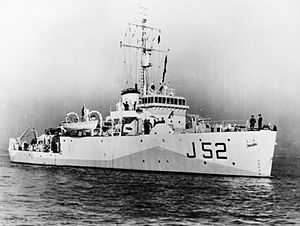HMS Guysborough (J52)
 | |
| Career (United Kingdom) | |
|---|---|
| Name: | Guysborough |
| Ordered: | 28 November 1940 |
| Builder: | North Vancouver Ship Repairs, North Vancouver |
| Laid down: | 28 May 1941 |
| Launched: | 21 July 1941 |
| Fate: | Loaned to Royal Canadian Navy 1942 |
| Career (Canada) | |
| Name: | Guysborough |
| Namesake: | Guysborough, Nova Scotia |
| Commissioned: | 22 April 1942 |
| Out of service: | 17 March 1945 |
| Honours and awards: | Atlantic 1943-44, Normandy 1944[1] |
| Fate: | Sunk by U-878 on 17 March 1945 |
| General characteristics | |
| Class and type: | Bangor-class minesweeper |
| Displacement: | 656 tons |
| Length: | 174 ft (53.0 m) |
| Beam: | 28.5 ft (8.7 m) |
| Draught: | 8.25 ft (2.5 m) |
| Propulsion: | Two Admiralty 3-drum water tube boilers two shafts coupled to steam turbines 2,000 shp (1,500 kW) |
| Speed: | 16 knots (30 km/h) |
| Complement: | 60 |
| Armament: |
|
HMS Guysborough was a turbine-engined Bangor-class minesweeper of the Royal Navy. Before commissioning she was transferred to the Royal Canadian Navy. She saw action in the Battle of the Atlantic and the Invasion of Normandy. She was torpedoed by U-868 in 1945 while returning to the United Kingdom.
Guysborough was ordered on 28 November 1940.[2] She was laid down on 28 May 1941 by North Van Ship Repairs Ltd. at North Vancouver and launched on 21 July later that year. She was loaned to the Royal Canadian Navy and commissioned on 22 April 1942.[3]
War service
After commissioning, Guysborough was assigned to Esquimalt Force. She remained with the unit until March 1943 when she transferred to the east coast, arriving at the end of April. She saw brief service with the Western Local Escort Force before joining the Halifax Local Defence Force.[3]
In mid-September 1943, Guysborough sailed to Baltimore where she underwent a refit that took six weeks to complete. In February 1944, she was sent to the United Kingdom as part of Canada's contribution to the invasion of Normandy. Upon arrival she was assigned to the 14th Minesweeping Flotilla and swept the invasion route of mines on D-day. She remained in UK waters until December when she returned to Canada to undergo another refit, this time at Lunenburg.[3]
Following the completion of the refit, Guysborough was ordered back to the United Kingdom. While en route, she was torpedoed.
Sinking
At 6:50pm on 17 March 1945 Guysborough was hit by a GNAT torpedo fired by U-868.[2][4] She had been sailing alone when she was hit. The torpedo struck the stern, which caused significant damage and a slight list to port, but the ship refused to sink. At 7:35pm, U-868 fired a coup de grâce which struck amidships on the starboard side of the ship. This caused the ship to sink much faster and it settled by the stern.[2]
Two crew members were killed in the explosions, a further 49 died while awaiting rescue.[2] 40 survivors were rescued by HMS Inglis 19 hours after the ship had been attacked.[2]
References
- Footnotes
- ↑ "Battle Honours". Britain's Navy. Retrieved 1 June 2014.
- ↑ 2.0 2.1 2.2 2.3 2.4 "HMCS Guysborough (J52)". uboat.net. Retrieved 1 June 2014.
- ↑ 3.0 3.1 3.2 Macpherson, Ken; Barrie, Ron (2002). The Ships of Canada's Naval Forces, 1910-2002 (3 ed.). St. Catharines: Vanwell Publishing Limited. p. 173. ISBN 1551250721.
- ↑ Colledge, J. J.; Warlow, Ben (2006) [1969]. Ships of the Royal Navy: The Complete Record of all Fighting Ships of the Royal Navy (Rev. ed.). London: Chatham Publishing. ISBN 978-1-86176-281-8. OCLC 67375475.
- Sources
- Colledge, J. J.; Warlow, Ben (2006) [1969]. Ships of the Royal Navy: The Complete Record of all Fighting Ships of the Royal Navy (Rev. ed.). London: Chatham Publishing. ISBN 978-1-86176-281-8. OCLC 67375475.
| ||||||||||||||||||